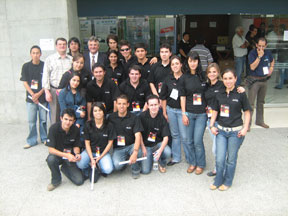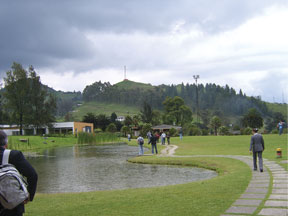Region 9 (Latin America) has two IEEE EMC Chapters,
in South Brazil and Colombia. During a trip to South America in
November 2007, Professor Franz Schlagenhaufer was invited by both
Chapters to give talks in Manizales, Colombia, and São
Paulo, Brazil on the topic: “Numerical Field Simulation
for EMC.” At the same time, Professor Carlos Sartori, chair
of the South Brazil EMC Chapter, was also invited to give a lecture
in Manizales regarding the fundamentals of EMC.
Manizales, the capital of the department Caldas, is a young city
(founded in 1849) with a population of about 400,000 in the Andean
region of Colombia. The important industries are growing coffee
and educating students. The Manizales campus of the Universidad
Nacional de Colombia was host to the IV Simposio Internacional
sobre Calidad de la Energía Eléctrica (SICEL 2007:
International Symposium on Power Quality) from 19-22 November
2007, and part of this event was dedicated to the topic of electromagnetic
compatibility.
On Wednesday 21 November, the third day of the four-day symposium,
an EMC workshop was organized. A welcome address from the IEEE
EMC Society President, Andrew Drozd, was read who congratulated
the young Colombian EMC Chapter on its recent formation. The presentations
covered computation of lightning induced transients in power lines,
fundamental EMC strategies, and numerical field simulation. A
second round of talks focused on research and EMC activities in
Colombia, other South American countries, and Australia. A panel
discussion concluded the EMC workshop.
With the EMC presentations being under the umbrella of a power
quality symposium, it was not astonishing that related topics,
such as over-voltages and lightning protection, were an essential
part. It once again highlighted the wide dynamic range of electromagnetic
problems, stretching from many kilovolts of potential disturbance
to few milivolt or even microvolts, and from DC and 50 Hz or 60
Hz to many GHz on the frequency scale. And while Maxwell’s
equations are the same all over the world, many empirical features
are not; lightning parameters, soil conductivity and remoteness
of installations can be quite different in the tropical regions
of South America and Europe or North America. Achieving the same
degree of power quality can therefore require different strategies
for grounding, shielding, or maintenance.
The symposium and EMC workshop were held at the University campus
and many students took the opportunity to attend the presentations.
It was refreshing to see that young people are enthusiastic about
engineering and research, and eager to learn about and work in
electrical and electronic engineering.
The second presentation by Professor Schlagenhaufer was to the
South Brazil EMC Chapter in São Paulo. While the Colombia
Chapter is one of the youngest IEEE EMC Chapters, South Brazil
is well established. And while Manizales is a reasonably small
city, São Paulo has in its metropolitan area a population
of 23 million people. A small but interested audience, with a
background mainly in the automotive and aircraft industries, attended
the presentation, held at the Escola Politécnica da Universidade
de São Paulo on 29 November 2007. With many high-tech industries
located in and around São Paulo, numerical field simulation
is not only important for companies, but also a relevant research
topic and a number of post graduate students among the audience
were evidence of that. EMC
 |
| Participants of SICEL 2007 are shown
in front of the lecture building at the Manizales campus of
the Universidad Nacional de Colombia. |
 |
| Franz Schlagenhaufer (in plaid shirt)
and Carlos Sartori (in tie) joined the group of students of
the Universidad Nacional de Colombia, Manizales who attended
SICEL 2007. |
 |
| Lunch during SICEL 2007 was located
in a very picturesque setting where many informal discussions
took place on the topic of EMC. |
 |
| Professor Carlos Sartori (second
from left) is shown with Professor Franz Schlagenhaufer (fourth
from left) following his presentation at the Escola Politécnica
da Universidade de São Paulo for the South Brazil Chapter. |



